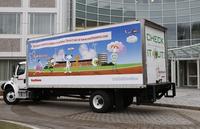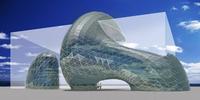-
Simulations helps overcome design challenges
Simulation software can pull volumes of complex data beyond simple measurements (think comparative load or stress tolerances) and layer that information into images; simulation can show how a bridge will perform based on how it is used, the conditions around it, its design, materials, and even variables such as the position of a joint — before a single component is manufactured or ground is broken
-
-
Raytheon highlights Mathematics Awareness Month activities
The importance of science, technology, engineering, and math (STEM) education to U.S. economic well-being and national security cannot be overemphasized; Raytheon is famous for its commitment to STEM education, and this month — Mathematics Awareness Month — the company highlights the many STEM-related activities it sponsors
-
-
Raytheon expands Pi Day annual celebration --

Pi, the mathematical constant approximately equal to 3.14, is significance in science, technology, engineering, and math (STEM) innovation; Raytheon expanded its annual Pi Day tradition, celebrated nationwide 14 March because of the date’s numerical significance; company employees delivered hundreds of apple pies nationwide to math and science teachers at middle and high schools located within a 3.14-mile radius of select Raytheon business locations across the country
-
-
Raytheon launches MathAlive! to encourage math, science education

Results of a new survey of America’s middle school students show that nearly half of students aged 10-14 enjoy learning math outside of school and consider hands-on activities their favorite method for experiencing new subject material; Raytheon launches MathAlive! to encourage students to study math, science, and engineering
-
-
Tails help leaping lizards – and robots – stay in control

A new study examined how lizards manage to leap successfully even when they slip and stumble; the researchers found that lizards swing their tails upward to prevent them from pitching head-over-heels into a rock; the research pushed the boundaries of control in robotics in an area researchers call inertial assisted robotics
-
-
Engineering lessons of Fukushima
Many engineers and scientists are still examining what happened at Fukushima during the earthqyake and tsunami of 11 March; one group, a Tsunami Loads-and-Effects Subcommittee sponsored by the American Society of Civil Engineers (ASCE), is preparing to publish early next year an approximately 350-page report
-
-
Earthquake prediction, a holy grail of science
Predicting earthquakes has proven to be an elusive pursuit for scientist and the mainstream consensus is that it will never happen, but one group remains hopeful; unlike the majority of geologists, who now believe it is nearly impossible to accurately predict earthquakes, those still searching for solutions tend to work in physics and atmospheric science
-
-
Placement of wind-turbine increases power tenfold

The power output of wind farms can be increased by an order of magnitude — at least tenfold — simply by optimizing the placement of turbines on a given plot of land; rather than build taller towers and bigger blades, efficient wind-based energy production should focus on the design of the wind farm itself, to maximize its energy-collecting efficiency at heights closer to the ground
-
-
China, U.K. pursue major rail projects; U.S. does not
Unlike almost every other developed nation, the United States has no national transportation strategy; the nation fails to raise taxes that are supposed to pay for roads and rails. Gasoline taxes, for example, cover only about 50 percent of road projects, much lower than in the past, according to recent Federal Highway Administration figures; once the U.S. recognizes that it needs diversified and integrated air, rail and road transportation, it could well end up importing the technologies, products and expertise it has failed to develop
-
-
Laws of traditional physics would foil Santa's effort to carry out mission
Santa has 31 hours to visit 378 million Christian children; at the rate of 3.5 children per household, and assuming at least one good child per home, this comes to 108 million homes; if each child receives no more than a medium sized Lego set (two pounds), the sleigh would be carrying more than 500 thousand tons, not counting Santa himself; Santa would thus need at least 360,000 Reindeer to pull the sleigh; since Santa must visit 108 million homes in 31 hours, he will have to travel at 650 miles per second — 3,000 times the speed of sound; at that speed, the lead pair of Reindeer would absorb 14.3 quintillion joules of energy per second each and vaporize – indeed, the entire Reindeer team would be vaporized within 4.26 thousandths of a second; Santa himself would be subjected to forces of 17,500 Gs; a 250 pound Santa (which seems ludicrously slim) would be pinned to the back of the sleigh by 4,315,015 pounds of force, and be crushed
-
-
String theory explains Santa Claus
Calculations maintain that the laws of physics should prevent Santa Claus from delivering all his gifts and that Santa would burn up in the atmosphere if he tried; the Norwegian Internet magazine, forskning.no, has put together a team of four top researchers to look into the case; the panel’s conclusion is clear: Santa can do the job and Christmas is saved!
-
-
Slowing climate warming may require geoengineering
Scientists warn that to avoid excessive warming, sea level rise, and extreme weather, CO2 in the atmosphere needs to be reduced to 350 parts-per-million (ppm) by the end of this century from the current level of around 390 ppm; one way to reduce atmospheric CO2 by the end of the century is by setting up fields of air-capture devices that absorb CO2, very similar to the carbon capture and storage technology being developed for coal plants
-
-
Geoengineering may affect different regions differently
Geoengineering approaches would succeed in restoring the average global temperature to “normal” levels, but some regions would remain too warm, whereas others would “overshoot” and cool too much; in addition, average rainfall would be reduced
-
-
Northeastern to build homeland security research center
A $12 million gift from an alum will allow Northeastern University to build a homeland security research facility on its Burlington campus; the George J. Kostas Research Institute for Homeland Security will be designed to Department of Defense specifications so Northeastern can gain clearances to conduct secure research on areas pertaining to national security, including cryptography, data security, information assurance, explosives detection, and energy harvesting
-
-
New Florida museum is glass-covered hurricane-proof fortress

The new Salvador Dali Museum in St. Petersburg is designed to withstand category 5 hurricanes; the roof is 12-inch thick solid concrete; the walls are even thicker, at eighteen inches; the glass, which makes up big sections of the outside of the museum, can hold up to a category 3 hurricane; if that glass breaks, letting rain, wind, and debris into the facility, the art will still be safe: storm doors will shield the galleries on the third floor, and the vault, which is on the second floor (all of the art is placed on the second and third floors, above the 30-foot storm surge of a category 5 storm)
-
- All
- Regional
- Water
- Biometrics
- Borders/Immig
- Business
- Cybersecurity
- Detection
- Disasters
- Government
- Infrastructure
- International
- Public health
- Public Safety
- Communication interoperabillity
- Emergency services
- Emergency medical services
- Fire
- First response
- IEDs
- Law Enforcement
- Law Enforcement Technology
- Military technology
- Nonlethal weapons
- Nuclear weapons
- Personal protection equipment
- Police
- Notification /alert systems
- Situational awareness
- Weapons systems
- Sci-Tech
- Sector Reports
- Surveillance
- Transportation
Advertising & Marketing: advertise@newswirepubs.com
Editorial: editor@newswirepubs.com
General: info@newswirepubs.com
2010-2011 © News Wire Publications, LLC News Wire Publications, LLC
220 Old Country Road | Suite 200 | Mineola | New York | 11501
Permissions and Policies
Editorial: editor@newswirepubs.com
General: info@newswirepubs.com
2010-2011 © News Wire Publications, LLC News Wire Publications, LLC
220 Old Country Road | Suite 200 | Mineola | New York | 11501
Permissions and Policies
